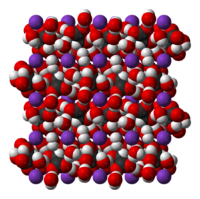Potassium sodium tartrate facts for kids
Quick facts for kids Sodium potassium L(+)-tartrate tetrahydrate |
|
|---|---|
 |
|
 |
|
| IUPAC name | Sodium potassium L(+)-tartrate tetrahydrate |
| Other names | E337; Seignette's salt; Rochelle salt |
| Identifiers | |
| CAS number | |
| PubChem | |
| EC number | 206-156-8 |
| SMILES | [K+].[Na+].O=C([O-])C(O)C(O)C([O-])=O |
|
InChI
InChI=1/C4H6O6.K.Na/c5-1(3(7)8)2(6)4(9)10;;/h1-2,5-6H,(H,7,8)(H,9,10);;/q;2*+1/p-2
|
|
| Properties | |
| Molecular formula | |
| Molar mass | 0 g mol-1 |
| Appearance | large colorless monoclinic needles |
| Odor | odorless |
| Density | 1.79 g/cm3 |
| Melting point | |
| Boiling point | |
| 26 g / 100 mL (0 °C); 66 g / 100 mL (26 °C) | |
| Solubility in ethanol | insoluble |
| Structure | |
| Crystal structure | orthorhombic |
| Except where noted otherwise, data are given for materials in their standard state (at 25 °C, 100 kPa) | |
Potassium sodium tartrate tetrahydrate, often called Rochelle salt, is a special type of double salt. It was first made around 1675 by a pharmacist named Pierre Seignette in La Rochelle, France. This is why it's also known as Seignette's salt.
Rochelle salt and another material, monopotassium phosphate, were the first substances found to have a property called piezoelectricity. This means they can create an electric charge when squeezed or pressed. This special ability made Rochelle salt very useful in the mid-1900s. It was used in things like crystal phonograph cartridges (for playing records), microphones, and headphones. These devices could produce a very strong sound signal. However, Rochelle salt can absorb moisture from the air (it's deliquescent), so devices using it could stop working if stored in damp places.
Contents
What is Rochelle Salt Used For?
Rochelle salt has many different uses, from medicine to science and even food.
Everyday Uses
- It has been used as a medicine to help with digestion.
- It helps in the process of silvering mirrors, making them shiny.
- It's a part of Fehling's solution, a chemical mix used to test for certain sugars.
- It's used in electroplating, which is a way to coat metal objects with a thin layer of another metal.
- It can even be found in cigarette paper to help it burn better.
Science and Food Uses
- In chemistry, it helps to separate mixtures that look like milky liquids, especially after certain reactions.
- It's important in the food industry for various purposes.
- Scientists use it to help grow protein crystals, which helps them study proteins.
- It's also an ingredient in the Biuret reagent, a solution used to measure how much protein is in a sample. It helps keep certain metal ions dissolved in the solution.
How is Rochelle Salt Made?
Rochelle salt is made from a starting material called cream of tartar, which is found naturally.
First, the cream of tartar is dissolved in water. Then, a hot solution of sodium hydroxide is added until the mixture reaches a certain pH level (around 8). After that, it's cleaned and filtered to remove impurities.
The cleaned liquid is then heated to make the water evaporate, making it thicker. As it cools slowly, the Rochelle salt starts to form crystals. These crystals are then separated from the liquid, washed, and dried. Finally, they are sorted by size and packaged.
Scientists have even grown larger Rochelle salt crystals in space aboard Skylab! This was done to see how crystals form without Earth's gravity.
It's important to know that Rochelle salt crystals can lose water if the air is too dry (below 30% humidity). They can also start to dissolve if the air is too humid (above 84% humidity).
The Discovery of Piezoelectricity
The special property of piezoelectricity was first shown using Rochelle salt.
In 1824, a scientist named Sir David Brewster observed these effects. He even gave the name "pyroelectricity" to a similar effect where materials create an electric charge when heated.
Later, in 1919, Alexander McLean Nicolson worked with Rochelle salt at Bell Labs. He used its piezoelectric properties to develop important audio inventions, like microphones and speakers, which helped shape modern sound technology.
Images for kids
-
Large Rochelle salt crystal grown aboard Skylab


